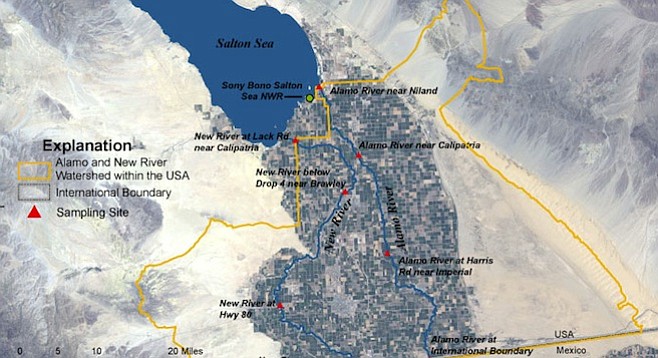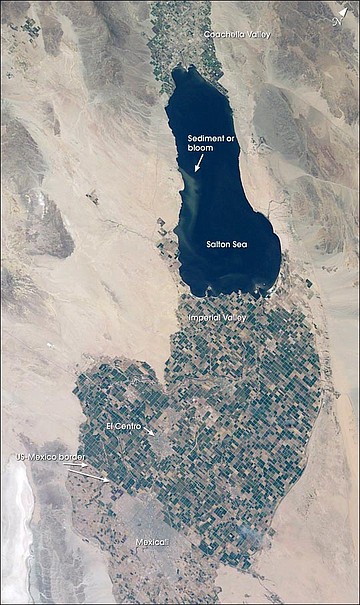 Facebook
Facebook
 X
X
 Instagram
Instagram
 TikTok
TikTok
 Youtube
Youtube

San Diegans haven't awakened to a major water-supply peril: the possibility that a 2003 deal arranged to bring water from the Imperial Valley could be in deep trouble.
A May 4 New Yorker article says that by 2021, the county will get 25 percent of its water from Imperial Valley. (A 2012 article published in the Reader, warning of the same peril, said the county was already getting 27 percent of its water from Imperial Valley. A Reader article published last year also addressed our reliance on Imperial Valley water.)

Much of the problem centers on the Salton Sea. It is drying up. The wind blows particulates and other dangerous matter around Imperial Valley. Childhood asthma in the region is the worst in the state. Also, farmers say they have insufficient water. The transfer of water to San Diego cuts off agricultural runoff that should replenish the Salton Sea. The state has promised to handle rehabilitation.
If there is no significant action by 2017, "the sea will begin to decline precipitously," worsening the health hazards, writes Dana Goodyear of the New Yorker. "Predictably, the relationship between the Imperial Irrigation District and the San Diego Water Authority has the barely subdued tension of an arranged marriage."
And then comes the ominous statement: "No restoration by 2017, no water for San Diego."
Writes Goodyear, "San Diego, of course, has a huge amount to lose. If the scenario at the Salton Sea seems like doomsday, imagine the San Diego of the near future, deprived of a quarter of its water in the middle of a megadrought."
And, she writes, San Diego has "virtually no natural water supply."
More noteworthy passages from the New Yorker piece:
Mary Nichols, the state’s top air-quality official, says, “The nightmare scenario is the pictures we’ve all seen of the Dust Bowl that contributed to the formation of California in the first place.”
…
It is hot in the valley, up to a hundred and twenty degrees in the summer months. The farmers tend to travel. Their wives may prefer to spend summers in La Jolla. Half the land is tenant-farmed; in some cases, the owners live elsewhere. “It functions as a plantation,” a local activist told me.
…
“We have an ‘Oh, shit’ deadline with 2017,” Keali’i Bright, the deputy secretary of legislative affairs at the California Natural Resources Agency, told me.
…
Suddenly, we were in treacherous territory, possibly offensive to the in-laws. The [Imperial Valley] farmers so piqued about giving up their water to San Diego were in fact San Diegans?
[San Diego Water Authority general manager Maureen] Stapleton glanced sharply at [her associate, Dan] Denham, and, when she thought I wasn’t looking, mouthed the word “careful.”


San Diegans haven't awakened to a major water-supply peril: the possibility that a 2003 deal arranged to bring water from the Imperial Valley could be in deep trouble.
A May 4 New Yorker article says that by 2021, the county will get 25 percent of its water from Imperial Valley. (A 2012 article published in the Reader, warning of the same peril, said the county was already getting 27 percent of its water from Imperial Valley. A Reader article published last year also addressed our reliance on Imperial Valley water.)

Much of the problem centers on the Salton Sea. It is drying up. The wind blows particulates and other dangerous matter around Imperial Valley. Childhood asthma in the region is the worst in the state. Also, farmers say they have insufficient water. The transfer of water to San Diego cuts off agricultural runoff that should replenish the Salton Sea. The state has promised to handle rehabilitation.
If there is no significant action by 2017, "the sea will begin to decline precipitously," worsening the health hazards, writes Dana Goodyear of the New Yorker. "Predictably, the relationship between the Imperial Irrigation District and the San Diego Water Authority has the barely subdued tension of an arranged marriage."
And then comes the ominous statement: "No restoration by 2017, no water for San Diego."
Writes Goodyear, "San Diego, of course, has a huge amount to lose. If the scenario at the Salton Sea seems like doomsday, imagine the San Diego of the near future, deprived of a quarter of its water in the middle of a megadrought."
And, she writes, San Diego has "virtually no natural water supply."
More noteworthy passages from the New Yorker piece:
Mary Nichols, the state’s top air-quality official, says, “The nightmare scenario is the pictures we’ve all seen of the Dust Bowl that contributed to the formation of California in the first place.”
…
It is hot in the valley, up to a hundred and twenty degrees in the summer months. The farmers tend to travel. Their wives may prefer to spend summers in La Jolla. Half the land is tenant-farmed; in some cases, the owners live elsewhere. “It functions as a plantation,” a local activist told me.
…
“We have an ‘Oh, shit’ deadline with 2017,” Keali’i Bright, the deputy secretary of legislative affairs at the California Natural Resources Agency, told me.
…
Suddenly, we were in treacherous territory, possibly offensive to the in-laws. The [Imperial Valley] farmers so piqued about giving up their water to San Diego were in fact San Diegans?
Comments[San Diego Water Authority general manager Maureen] Stapleton glanced sharply at [her associate, Dan] Denham, and, when she thought I wasn’t looking, mouthed the word “careful.”